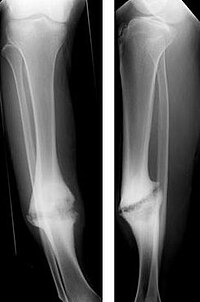
Photo from wikipedia
Introduction: This video demonstrates the technique of posterolateral bone grafting with iliac crest bone graft for a distal tibial nonunion. Methods: The patient is a 42-year-old man who is 6… Click to show full abstract
Introduction: This video demonstrates the technique of posterolateral bone grafting with iliac crest bone graft for a distal tibial nonunion. Methods: The patient is a 42-year-old man who is 6 months status post an open distal tibia–fibula fracture treated surgically, and presents complaints of persistent right ankle pain. The fracture site was tender to palpation, and 3 consecutive plain radiographs spaced 6 weeks apart demonstrated no evidence of callus formation. Results: This patient was indicated for posterolateral bone grafting of his tibia and fibula nonunion with autogenous iliac crest bone graft. The plan was to create a synostosis between the fibula and tibia. Atrophic and oligotrophic nonunions have poor biology at the fracture site to promote bone growth and would therefore benefit from autogenous iliac bone graft, as this technique is osteoinductive, osteoconductive, and osteogenic stem cells. Indications for posterolateral bone grafting of the tibia include atrophic or oligotrophic nonunions, an ipsilateral same level tibia and fibula nonunion, or a tibial nonunion with a large anteromedial soft-tissue injury. Conclusion: The technique of posterolateral bone grafting with iliac crest bone graft for distal third tibia and fibula atrophic nonunion provides a reliable method for achieving union. If patients with injuries at high risk of nonunion are followed closely and intervention is performed in a timely manner, additional fixation or revision of fixation is not necessary if the addition of appropriate osteoinductive, osteoconductive, and osteogenic material to the nonunion is performed.
Journal Title: Journal of Orthopaedic Trauma
Year Published: 2017
Link to full text (if available)
Share on Social Media: Sign Up to like & get
recommendations!